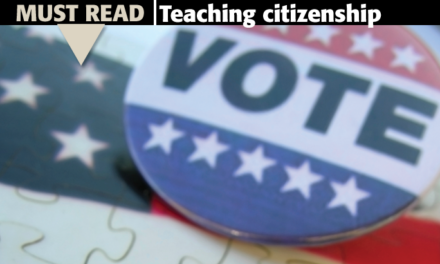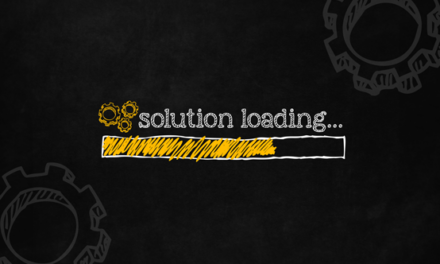Intellectual work, communicative collaboration, and shared inspiration can help principals and assistant principals see eye to eye.
My principal and I often tell people “We have trouble seeing eye to eye.” A former Bostonian with a punchy East Coast temper, Mark Barry stands at 5-foot-2 and is typically clad in outdoor gear. As one of his assistant principals, I tower over him at 6 feet, my Minnesota Nice demeanor in dissonance with my conspicuous full-sleeve tattoos. Indeed we are a sight to behold!
This inability to see eye to eye may be an accurate portrayal of our physical presence, but it could not be a more inaccurate description of our professional relationship. Through intentionally cultivated behaviors, we have developed a model of professional practice that not only nourishes our interpersonal relationship, but also exemplifies an embodied form of positive and productive leadership.
To exist as an embodied leader in public education is to live with a presence, magnetism, and hopeful inspiration that integrates our heads and hearts. As Forbes writer Ginny Whitelaw (2020) explains, a leadership style that dissociates head from heart, talk from walk, and action from a felt sense of its consequences is “wholly inadequate for dealing with the wicked issues we face.” Our embodied presence — in which we are fully ourselves — is a key foundation for the principal/assistant principal relationship. For this reason, our administrative team leans wholly into professional practices that nourish our relationships as principal and assistant principals. These practices fall into three domains: intellectual work, communicative collaboration, and inspiration seeking. The combination enables us to embrace our whole selves, as colleagues and educational leaders.

Intellectual work: Professional dialogue
Our school — Fossil Ridge High School in Fort Collins — is ranked by U.S. News (2023) as the highest-achieving public high school in Northern Colorado. Rigorous in its academic offerings, Fossil Ridge values choice, enrichment, and belonging for students with wide-ranging academic and personal interests. Our leadership team engages in and models meaningful ongoing intellectual work as a professional practice. Just as classroom teachers may engage in dialogue about teaching practices, we engage in regular dialogue about our work through professional dialogue appointments.
As administrative partners, we revere the intellectual work of public education and prioritize cultivating intentional, formal spaces for discussing problems of practice. In professional dialogue processes, educators “have to go beyond simply sharing practice; they have to emphasize investigating their practice in order to bring about positive changes to their teaching and pupils’ learning” (Nelson et al., 2010, as cited in Cheng & Winnie, 2012, p. 326). Our conversations take an investigative approach as we consider a variety of academic topics: equitable grading, pedagogical philosophy, master scheduling, professional development programming, shifts in student demographics — the list is long and varied.
Due to the “tyranny of the urgent” that often accompanies administrative roles, guarding and protecting this space is of the utmost priority. We’ve created ongoing lists of academic topics and schedule formal professional dialogue conversations about these topics every few weeks. During these professional dialogues, we often access research, share excerpts from readings, review data, and debate. When considering significant schoolwide shifts in long-standing cultural practices, the rich, lengthy, and spirited professional dialogue in which our team engages allows us to land at discerning, defensible, and values-based decisions.
Intellectual work grounded in professional dialogue has several benefits for our administrative team’s relationships as principal and assistant principals. Creating a sense of shared leadership, this practice gives us a feeling of intellectual comradery that constantly returns us to our basic foundations as educators. It also results in data-informed decision making that brings about continuous improvement and a thorough, multifaceted approach to problem solving. This strategy models to our staff that we value exploring the tensions of today’s educational problems and want to actively discuss current challenges in teaching and learning. As the lead learners in our building who know and study relevant research and best practice, we are able to encourage teachers to be reflective practitioners as well.
Communicative collaboration: Conversation partnerships
Educators are not strangers to the notion that collaboration is a powerful way to increase innovation, calibrate instructional tools, weigh decisions, and improve achievement. John Hattie’s (2012) research on visible learning underscores the benefits of collaboration for school performance and culture. This seminal work paved the way for additional theorizing about the connection between collaboration and collective efficacy. When educators share a sense of collective efficacy, schools tend to have high expectations for student success and a shared focus on deeper learning, as opposed to mere compliance (Donohoo, Hattie, & Eells, 2018).
The research surrounding collective efficacy and collaborative practice has led us to make collaboration a fundamental tenet of our leadership practice. To support our collaborative relationship, we use a model called “conversation partnership” as a framework for checking each other’s thinking. When facing difficult decisions, programming options, or dialogue with staff or parents, we turn to each other and ask for an informal conversation partnership to sift through our feelings, organize our thinking, deliberate on our decisions, rehearse conversations, or process situations that have proven to be taxing. The collaborative conversation adds breadth to our understanding of the challenging topics we individually face.
Too often, the weight of the work and the routine banality of the daily grind makes it difficult for educational leaders to truly see and feel the wonder unfolding in our schools.
While an independent approach to these challenges may be more efficient, turning toward one another for collaboration and working as a unit is good for all of us. Our problem-solving capacities grow as we lean into one another’s creativity, compassion, and experiences as a source of information and, sometimes, solace. Conversation partnerships build our trust and empathy, allowing us to have stronger mutual understanding of the leadership challenges we face individually and collectively. Winnowing through the trenches of the daily work together increases our sense of professional satisfaction and confidence.
This feeling translates to our staff. They witness, in real time, the benefits of collaborative educational relationships and observe that collaboration, indeed, translates to a sense of efficacy and shared success. We model humility by asking for help, and we treat teamwork as a norm instead of a rhetorical construct. When staff see capable and trusted leaders leaning into one another, they are inspired to follow suit and work with their peers for the greater good. Success lies in communicative collaboration and the belief that together, we can achieve better.
Inspiration: Awe walks
The work of public education is hard. To offset the weight of the challenge, we need to find ways to be inspired so we can transmit a sense of inspiration to our staff. To cultivate this feeling, we use an intentional move called awe walks.
Neuroscientist Virginia Strum and her co-authors (2023) have studied the benefit of the “awe walk” in which walkers were encouraged to seek awe while in motion. People across cultures have found that awe brings us into a heightened state of awareness and sparks in us a childlike sense of wonder. We approach what we see daily with fresh eyes, as if seeing for the first time. We are called to take in the vastness around us while also considering the minutia. Walks may involve going somewhere new, but if it is not possible, we can work to find something new in familiar spaces. That’s what we do on our awe walks.
Too often, the weight of the work and the routine banality of the daily grind makes it difficult for educational leaders to truly see and feel the wonder unfolding in our schools. By instituting an intentional, mindful, sensory exploration of our daily environment, we build an increased consciousness of gratitude, marvel, and fulfillment. Carving time to literally walk the spaces of our school once a quarter with a lens of inspiration and gratitude connects us to our people, our place, and our purpose. It reinforces our pride in our work and helps us reimagine ourselves in a refreshed light. For psychologist Dachner Keltner (2023), awe has transformative power.
A walk earlier this fall brought us to our performing arts complex. We attuned to the sounds and sights of a production in its infant preparatory phases, building our empathy and compassion for those involved in the nuanced work and immense detail required to create a show. We humbly felt gratitude for the blessing of the physical space afforded to our theater programming. We noted colors, signage, the stonework of the walls — all the small elements that contribute to building a grandiose context suitable for a performance. Overtaken by emotion, we identified the palpable energy in the space and thought about the myriad feelings students and families have likely experienced in the seats of our theater: nervousness, thrill, confidence, fear. For us, the data we gather and discuss on awe walks like this one nurture not just us but also our staff and students. The energy and (re)imagination we experience through an awe walk encourages others to invest in the same practices.
A model relationship
Administrators shape and control the narrative of the school. Their relationships become models for the relationships within the school, and their leadership moves percolate throughout the school, serving as indicators of school culture and values. If their relationships showcase a commitment to ongoing intellectual work, a preference for collaborative conversation, and an intentional gratitude practice, the school climate becomes less about compliance and survival and foregrounds growth, healthy expectations, and meaningful relationships.
Seeing eye to eye begins with dedicating intentional time to practices that bring a desired future into the present. Without doing the inner work, individually and as a team, and learning to embody their beliefs, school leaders cannot fully do the outer work that will connect their beliefs to their practice and the life of their school.
References
Cheng, M. & Winnie, M. (2012). Analysing teacher professional development through professional dialogue: An investigation into a university–school partnership project on enquiry learning. Journal of Education for Teaching, 38 (3), 323-341.
Donohoo, J., Hattie, J., & Eells, R. (2018). The power of collective efficacy. Educational Leadership, 75 (6), 40-44.
Hattie, J. (2012). Visible learning for teachers: Maximizing impact on learning. Routledge.
Keltner, D. (2023). Awe: The new science of everyday wonder and how it can transform your life. Penguin Press.
Sturm, V.E., Datta, S., Roy, A.R.K., Sible, I.J., Kosik, E.L., Veziris, C.R., Chow, T.E., Morris, N.A., Neuhaus, J., Kramer, J.H., Miller, B.L., Holley, S.R., & Keltner, D. (2022). Big smile, small self: Awe walks promote prosocial positive emotions in older adults. Emotion, 22 (5), 1044-1058.
U.S. News and World Report. (2023, Oct.) Fossil Ridge High School. Best High Schools.
Whitelaw, G. (2020, October 19). Embodied leadership: A cure for what ails us? Forbes.
This article appears in the May 2024 issue of Kappan, Vol. 105, No. 8, p. 44-47.
ABOUT THE AUTHOR

Sonja Gedde
Sonja Gedde is assistant principal of Fossil Ridge High School and an affiliate professor at Colorado State University, both in Fort Collins, CO.













